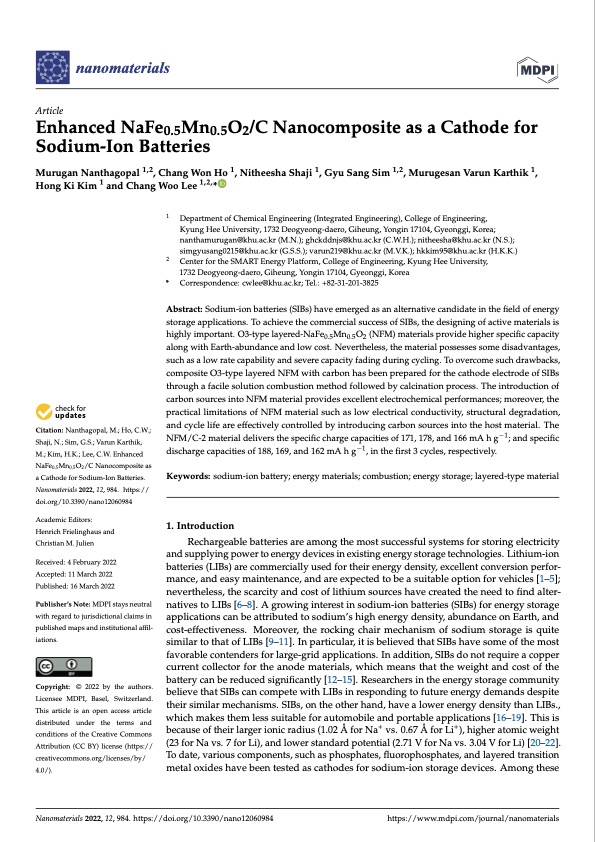
PDF Publication Title:
Text from PDF Page: 001
nanomaterials Article Enhanced NaFe0.5Mn0.5O2/C Nanocomposite as a Cathode for Sodium-Ion Batteries Murugan Nanthagopal 1,2, Chang Won Ho 1, Nitheesha Shaji 1, Gyu Sang Sim 1,2, Murugesan Varun Karthik 1, Hong Ki Kim 1 and Chang Woo Lee 1,2,* Citation: Nanthagopal, M.; Ho, C.W.; Shaji, N.; Sim, G.S.; Varun Karthik, M.; Kim, H.K.; Lee, C.W. Enhanced NaFe0.5Mn0.5O2/C Nanocomposite as a Cathode for Sodium-Ion Batteries. Nanomaterials2022,12,984. https:// doi.org/10.3390/nano12060984 Academic Editors: Henrich Frielinghaus and Christian M. Julien Received: 4 February 2022 Accepted: 11 March 2022 Published: 16 March 2022 Publisher’s Note: MDPI stays neutral with regard to jurisdictional claims in published maps and institutional affil- iations. Copyright: © 2022 by the authors. Licensee MDPI, Basel, Switzerland. This article is an open access article distributed under the terms and conditions of the Creative Commons Attribution (CC BY) license (https:// creativecommons.org/licenses/by/ 4.0/). 1 2 * Correspondence: cwlee@khu.ac.kr; Tel.: +82-31-201-3825 Abstract: Sodium-ion batteries (SIBs) have emerged as an alternative candidate in the field of energy storage applications. To achieve the commercial success of SIBs, the designing of active materials is highly important. O3-type layered-NaFe0.5Mn0.5O2 (NFM) materials provide higher specific capacity along with Earth-abundance and low cost. Nevertheless, the material possesses some disadvantages, such as a low rate capability and severe capacity fading during cycling. To overcome such drawbacks, composite O3-type layered NFM with carbon has been prepared for the cathode electrode of SIBs through a facile solution combustion method followed by calcination process. The introduction of carbon sources into NFM material provides excellent electrochemical performances; moreover, the practical limitations of NFM material such as low electrical conductivity, structural degradation, and cycle life are effectively controlled by introducing carbon sources into the host material. The NFM/C-2 material delivers the specific charge capacities of 171, 178, and 166 mA h g−1; and specific discharge capacities of 188, 169, and 162 mA h g−1, in the first 3 cycles, respectively. Keywords: sodium-ion battery; energy materials; combustion; energy storage; layered-type material 1. Introduction Rechargeable batteries are among the most successful systems for storing electricity and supplying power to energy devices in existing energy storage technologies. Lithium-ion batteries (LIBs) are commercially used for their energy density, excellent conversion perfor- mance, and easy maintenance, and are expected to be a suitable option for vehicles [1–5]; nevertheless, the scarcity and cost of lithium sources have created the need to find alter- natives to LIBs [6–8]. A growing interest in sodium-ion batteries (SIBs) for energy storage applications can be attributed to sodium’s high energy density, abundance on Earth, and cost-effectiveness. Moreover, the rocking chair mechanism of sodium storage is quite similar to that of LIBs [9–11]. In particular, it is believed that SIBs have some of the most favorable contenders for large-grid applications. In addition, SIBs do not require a copper current collector for the anode materials, which means that the weight and cost of the battery can be reduced significantly [12–15]. Researchers in the energy storage community believe that SIBs can compete with LIBs in responding to future energy demands despite their similar mechanisms. SIBs, on the other hand, have a lower energy density than LIBs., which makes them less suitable for automobile and portable applications [16–19]. This is because of their larger ionic radius (1.02 Å for Na+ vs. 0.67 Å for Li+), higher atomic weight (23 for Na vs. 7 for Li), and lower standard potential (2.71 V for Na vs. 3.04 V for Li) [20–22]. To date, various components, such as phosphates, fluorophosphates, and layered transition metal oxides have been tested as cathodes for sodium-ion storage devices. Among these Department of Chemical Engineering (Integrated Engineering), College of Engineering, Kyung Hee University, 1732 Deogyeong-daero, Giheung, Yongin 17104, Gyeonggi, Korea; nanthamurugan@khu.ac.kr (M.N.); ghckddnjs@khu.ac.kr (C.W.H.); nitheesha@khu.ac.kr (N.S.); simgyusang0215@khu.ac.kr (G.S.S.); varun219@khu.ac.kr (M.V.K.); hkkim95@khu.ac.kr (H.K.K.) Center for the SMART Energy Platform, College of Engineering, Kyung Hee University, 1732 Deogyeong-daero, Giheung, Yongin 17104, Gyeonggi, Korea Nanomaterials 2022, 12, 984. https://doi.org/10.3390/nano12060984 https://www.mdpi.com/journal/nanomaterialsPDF Image | NaFe0 Nanocomposite as a Cathode for Sodium-Ion Batteries

PDF Search Title:
NaFe0 Nanocomposite as a Cathode for Sodium-Ion BatteriesOriginal File Name Searched:
nanomaterials-12-00984-v2.pdfDIY PDF Search: Google It | Yahoo | Bing
Salgenx Redox Flow Battery Technology: Salt water flow battery technology with low cost and great energy density that can be used for power storage and thermal storage. Let us de-risk your production using our license. Our aqueous flow battery is less cost than Tesla Megapack and available faster. Redox flow battery. No membrane needed like with Vanadium, or Bromine. Salgenx flow battery
| CONTACT TEL: 608-238-6001 Email: greg@salgenx.com | RSS | AMP |